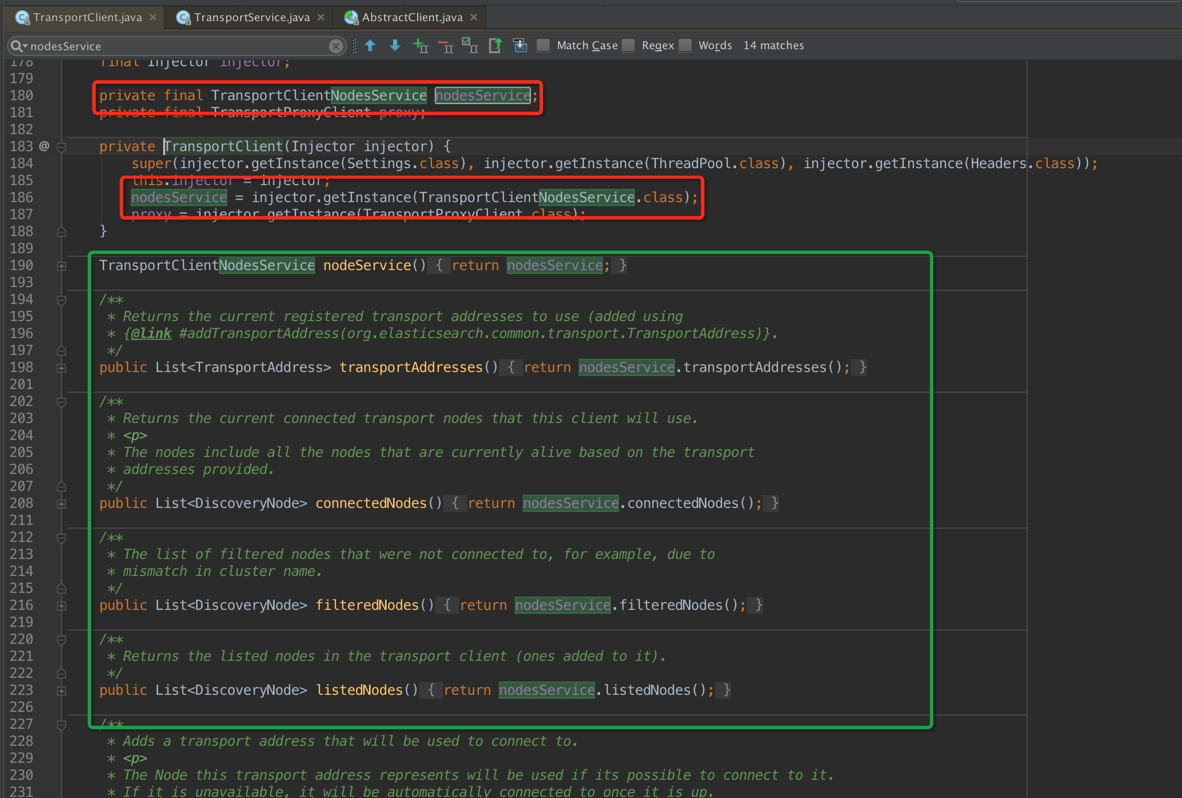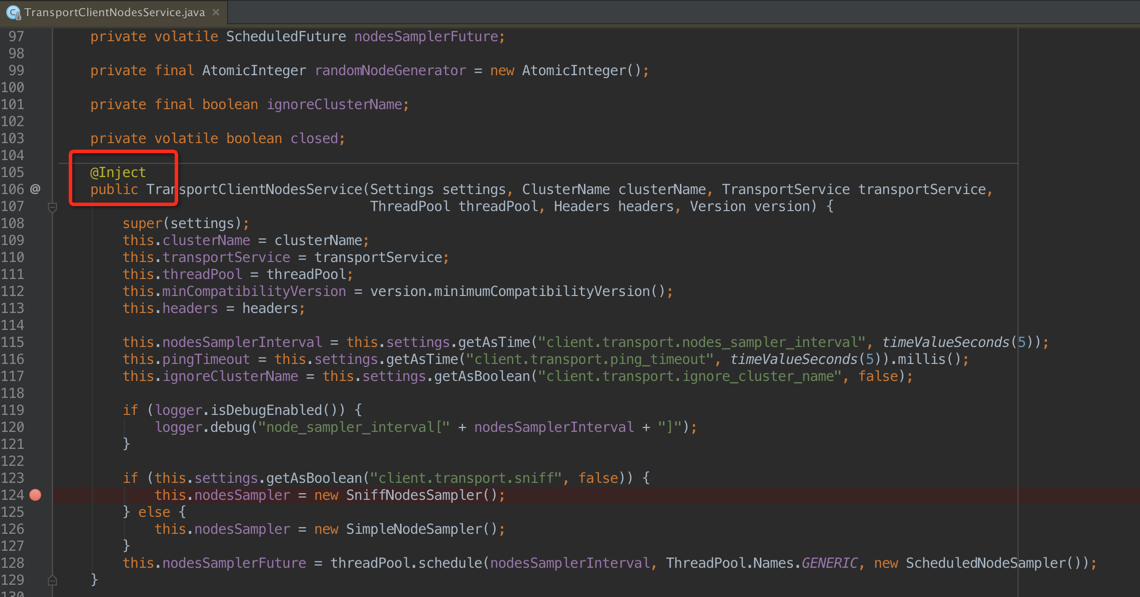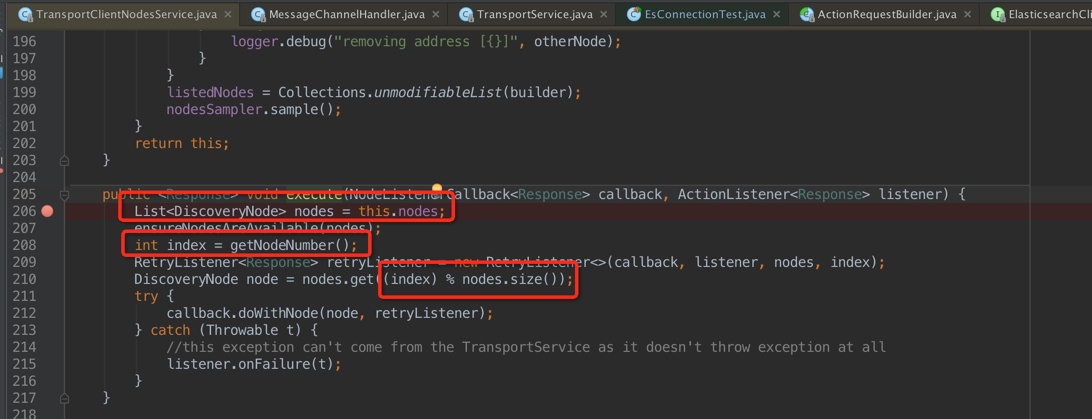Elasticsearch之client源码简要分析
来源:互联网 发布:mac如何重装 编辑:程序博客网 时间:2024/06/05 14:21
问题
让我们带着问题去学习,效率会更高
1 es集群只配置一个节点,client是否能够自动发现集群中的所有节点?是如何发现的?
2 es client如何做到负载均衡?
3 一个es node挂掉之后,es client如何摘掉该节点?
4 es client node检测分为两种模式(SimpleNodeSampler和SniffNodesSampler),有什么不同?
核心类
- TransportClient es client对外API类
- TransportClientNodesService 维护node节点的类
- ScheduledNodeSampler 定期维护正常节点类
- NettyTransport 进行数据传输
- NodeSampler 节点嗅探器
Client初始化过程
初始化代码
1 Settings.Builder builder = Settings.settingsBuilder() .put("cluster.name", clusterName) .put("client.transport.sniff", true);Settings settings = builder.build(); 2 TransportClient client = TransportClient.builder().settings(settings).build(); 3 for (TransportAddress transportAddress : transportAddresses) { client.addTransportAddress(transportAddress);}
1 ES 通过builder模式构造了基础的配置参数;
2 通过build构造了client,这个时候包括构造client、初始化ThreadPool、构造TransportClientNodesService、启动定时任务、定制化嗅探类型;
3 添加集群可用地址,比如我只配了集群中的一个节点;
构建client
调用build API

其中,关于依赖注入的简单说明:Guice 是 Google 用于 Java™ 开发的开放源码依赖项注入框架(感兴趣的可以了解下,这里不做重点讲解),具体可参考下边链接:
- https://github.com/google/guice/wiki/GettingStarted
- http://www.cnblogs.com/whitewolf/p/4185908.html
- http://www.ibm.com/developerworks/cn/java/j-guice.html
初始化TransportClientNodesService
在上一幅图的 modules.createInjector对TransportClientNodesService进行实例化,在TransportClient进行注入,可以看到TransportClient里边的绝大部分API都是通过TransportClientNodesService进行代理的

Guice通过注解进行注入

在上图中:注入了集群名称、线程池等,重点是如下代码:该段代码选择了节点嗅探器的类型 嗅探同一集群中的所有节点(SniffNodesSampler)或者是只关注配置文件配置的节点(SimpleNodeSampler)
if (this.settings.getAsBoolean("client.transport.sniff", false)) { this.nodesSampler = new SniffNodesSampler();} else { this.nodesSampler = new SimpleNodeSampler();}
特点:
SniffNodesSampler:client会主动发现集群里的其他节点,会创建fully connect(什么叫fully connect?后边说)
SimpleNodeSampler:ping listedNodes中的所有node,区别在于这里创建的都是light connect;
其中TransportClientNodesService维护了三个节点存储数据结构:
// nodes that are added to be discovered
1 private volatile List<DiscoveryNode> listedNodes = Collections.emptyList();
2 private volatile List<DiscoveryNode> nodes = Collections.emptyList();
3 private volatile List<DiscoveryNode> filteredNodes = Collections.emptyList();
1 代表配置文件中主动加入的节点;
2 代表参与请求的节点;
3 过滤掉的不能进行请求处理的节点;
Client如何做到负载均衡

如上图,我们发现每次 execute 的时候,是从 nodes 这个数据结构中获取节点,然后通过简单的 rouund-robbin 获取节点服务器;核心代码如下:
private final AtomicInteger randomNodeGenerator = new AtomicInteger();......private int getNodeNumber() { int index = randomNodeGenerator.incrementAndGet(); if (index < 0) { index = 0; randomNodeGenerator.set(0); } return index;}
然后通过netty的channel将数据写入,核心代码如下:
public void sendRequest(final DiscoveryNode node, final long requestId, final String action, final TransportRequest request, TransportRequestOptions options) throws IOException, TransportException { Channel targetChannel = nodeChannel(node, options); if (compress) { options = TransportRequestOptions.builder(options).withCompress(true).build(); } byte status = 0; status = TransportStatus.setRequest(status); ReleasableBytesStreamOutput bStream = new ReleasableBytesStreamOutput(bigArrays); boolean addedReleaseListener = false; try { bStream.skip(NettyHeader.HEADER_SIZE); StreamOutput stream = bStream; // only compress if asked, and, the request is not bytes, since then only // the header part is compressed, and the "body" can't be extracted as compressed if (options.compress() && (!(request instanceof BytesTransportRequest))) { status = TransportStatus.setCompress(status); stream = CompressorFactory.defaultCompressor().streamOutput(stream); } // we pick the smallest of the 2, to support both backward and forward compatibility // note, this is the only place we need to do this, since from here on, we use the serialized version // as the version to use also when the node receiving this request will send the response with Version version = Version.smallest(this.version, node.version()); stream.setVersion(version); stream.writeString(action); ReleasablePagedBytesReference bytes; ChannelBuffer buffer; // it might be nice to somehow generalize this optimization, maybe a smart "paged" bytes output // that create paged channel buffers, but its tricky to know when to do it (where this option is // more explicit). if (request instanceof BytesTransportRequest) { BytesTransportRequest bRequest = (BytesTransportRequest) request; assert node.version().equals(bRequest.version()); bRequest.writeThin(stream); stream.close(); bytes = bStream.bytes(); ChannelBuffer headerBuffer = bytes.toChannelBuffer(); ChannelBuffer contentBuffer = bRequest.bytes().toChannelBuffer(); buffer = ChannelBuffers.wrappedBuffer(NettyUtils.DEFAULT_GATHERING, headerBuffer, contentBuffer); } else { request.writeTo(stream); stream.close(); bytes = bStream.bytes(); buffer = bytes.toChannelBuffer(); } NettyHeader.writeHeader(buffer, requestId, status, version); ChannelFuture future = targetChannel.write(buffer); ReleaseChannelFutureListener listener = new ReleaseChannelFutureListener(bytes); future.addListener(listener); addedReleaseListener = true; transportServiceAdapter.onRequestSent(node, requestId, action, request, options); } finally { if (!addedReleaseListener) { Releasables.close(bStream.bytes()); } }}其中最重要的就是1和2,中间一段是处理数据和进行一些必要的步骤
1代表拿到一个连接;
2代表通过拿到的连接写数据;
这时候就会有新的问题
1 nodes的数据是何时写入的?
2 连接是什么时候创建的?
Nodes数据何时写入
核心是调用doSampler,代码如下:
protected void doSample() { // the nodes we are going to ping include the core listed nodes that were added // and the last round of discovered nodes Set<DiscoveryNode> nodesToPing = Sets.newHashSet(); for (DiscoveryNode node : listedNodes) { nodesToPing.add(node); } for (DiscoveryNode node : nodes) { nodesToPing.add(node); } final CountDownLatch latch = new CountDownLatch(nodesToPing.size()); final ConcurrentMap<DiscoveryNode, ClusterStateResponse> clusterStateResponses = ConcurrentCollections.newConcurrentMap(); for (final DiscoveryNode listedNode : nodesToPing) { threadPool.executor(ThreadPool.Names.MANAGEMENT).execute(new Runnable() { @Override public void run() { try { if (!transportService.nodeConnected(listedNode)) { try { // if its one of the actual nodes we will talk to, not to listed nodes, fully connect if (nodes.contains(listedNode)) { logger.trace("connecting to cluster node [{}]", listedNode); transportService.connectToNode(listedNode); } else { // its a listed node, light connect to it... logger.trace("connecting to listed node (light) [{}]", listedNode); transportService.connectToNodeLight(listedNode); } } catch (Exception e) { logger.debug("failed to connect to node [{}], ignoring...", e, listedNode); latch.countDown(); return; } } //核心是在这里,刚刚开始初始化的时候,可能只有配置的一个节点,这个时候会通过这个地址发送一个state状态监测 //"cluster:monitor/state" transportService.sendRequest(listedNode, ClusterStateAction.NAME, headers.applyTo(Requests.clusterStateRequest().clear().nodes(true).local(true)), TransportRequestOptions.builder().withType(TransportRequestOptions.Type.STATE).withTimeout(pingTimeout).build(), new BaseTransportResponseHandler<ClusterStateResponse>() { @Override public ClusterStateResponse newInstance() { return new ClusterStateResponse(); } @Override public String executor() { return ThreadPool.Names.SAME; } @Override public void handleResponse(ClusterStateResponse response) {/*通过回调,会在这个地方返回集群中类似下边所有节点的信息{ "version" : 27, "state_uuid" : "YSI9d_HiQJ-FFAtGFCVOlw", "master_node" : "TXHHx-XRQaiXAxtP1EzXMw", "blocks" : { }, "nodes" : { "7" : { "name" : "es03", "transport_address" : "1.1.1.1:9300", "attributes" : { "data" : "false", "master" : "true" } }, "6" : { "name" : "common02", "transport_address" : "1.1.1.2:9300", "attributes" : { "master" : "false" } }, "5" : { "name" : "es02", "transport_address" : "1.1.1.3:9300", "attributes" : { "data" : "false", "master" : "true" } }, "4" : { "name" : "common01", "transport_address" : "1.1.1.4:9300", "attributes" : { "master" : "false" } }, "3" : { "name" : "common03", "transport_address" : "1.1.1.5:9300", "attributes" : { "master" : "false" } }, "2" : { "name" : "es01", "transport_address" : "1.1.1.6:9300", "attributes" : { "data" : "false", "master" : "true" } }, "1" : { "name" : "common04", "transport_address" : "1.1.1.7:9300", "attributes" : { "master" : "false" } } }, "metadata" : { "cluster_uuid" : "_na1x_", "templates" : { }, "indices" : { } }, "routing_table" : { "indices" : { } }, "routing_nodes" : { "unassigned" : [ ], }}*/ clusterStateResponses.put(listedNode, response); latch.countDown(); } @Override public void handleException(TransportException e) { logger.info("failed to get local cluster state for {}, disconnecting...", e, listedNode); transportService.disconnectFromNode(listedNode); latch.countDown(); } }); } catch (Throwable e) { logger.info("failed to get local cluster state info for {}, disconnecting...", e, listedNode); transportService.disconnectFromNode(listedNode); latch.countDown(); } } }); } try { latch.await(); } catch (InterruptedException e) { return; } HashSet<DiscoveryNode> newNodes = new HashSet<>(); HashSet<DiscoveryNode> newFilteredNodes = new HashSet<>(); for (Map.Entry<DiscoveryNode, ClusterStateResponse> entry : clusterStateResponses.entrySet()) { if (!ignoreClusterName && !clusterName.equals(entry.getValue().getClusterName())) { logger.warn("node {} not part of the cluster {}, ignoring...", entry.getValue().getState().nodes().localNode(), clusterName); newFilteredNodes.add(entry.getKey()); continue; }//接下来在这个地方拿到所有的data nodes 写入到nodes节点里边 for (ObjectCursor<DiscoveryNode> cursor : entry.getValue().getState().nodes().dataNodes().values()) { newNodes.add(cursor.value); } } nodes = validateNewNodes(newNodes); filteredNodes = Collections.unmodifiableList(new ArrayList<>(newFilteredNodes));}其中调用时机分为两部分:
1 client.addTransportAddress(transportAddress);
2 ScheduledNodeSampler,默认每隔5s会进行一次对各个节点的请求操作;
连接是何时创建的呢
也是在doSampler调用,最终由NettryTransport创建

这个时候发现,如果是light则创建轻连接,也就是,否则创建fully connect,其中包括
- recovery:做数据恢复recovery,默认个数2个;
- bulk:用于bulk请求,默认个数3个;
- med/reg:典型的搜索和单doc索引,默认个数6个;
- high:如集群state的发送等,默认个数1个;
- ping:就是node之间的ping咯。默认个数1个;
对应的代码为:
public void start() { List<Channel> newAllChannels = new ArrayList<>(); newAllChannels.addAll(Arrays.asList(recovery)); newAllChannels.addAll(Arrays.asList(bulk)); newAllChannels.addAll(Arrays.asList(reg)); newAllChannels.addAll(Arrays.asList(state)); newAllChannels.addAll(Arrays.asList(ping)); this.allChannels = Collections.unmodifiableList(newAllChannels);}
转自:http://blog.csdn.net/xgjianstart/article/details/65935625
- Elasticsearch之client源码简要分析
- Elasticsearch之client源码简要分析
- elasticsearch源码分析之客户端(三)
- elasticsearch源码分析之服务端(四)
- elasticsearch源码分析之Transport(五)
- elasticsearch源码分析之Gateway(六)
- elasticsearch源码分析之discovery(七)
- elasticsearch源码分析之客户端(三)
- elasticsearch源码分析之服务端(四)
- elasticsearch源码分析之Transport(五)
- elasticsearch源码分析之Gateway(六)
- elasticsearch源码分析之discovery(七)
- elasticsearch源码分析之启动过程
- elasticsearch源码分析之java客户端
- elasticsearch源码分析之集群服务(八)
- elasticsearch源码分析之search查询(十一)
- elasticsearch源码分析之集群管理
- elasticsearch 源码简单分析之【tmp目录】
- Hadoop学习——向MapReduce提交计算任务的基本流程
- 史上最全解析Android消息推送解决方案
- RC5编码格式的遥控器解码、PCA9633器件控制代码示例、串口通信程序示例、IIC通信示例
- c语言中__attribute__的意义
- Android 应用启动图标未读消息数显示
- Elasticsearch之client源码简要分析
- H264编码规范
- iOS-拨打电话三种方式(修改后)
- Hrbust 1683/Hdu 4340 Alice和Bob的国家【树型Dp+思维】
- 录音APP
- Docker容器数据管理1
- eclipse中maven项目交付svn忽略配置文件
- MAVEN2
- 搜索-Q



